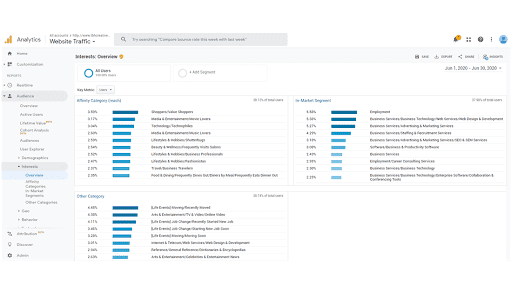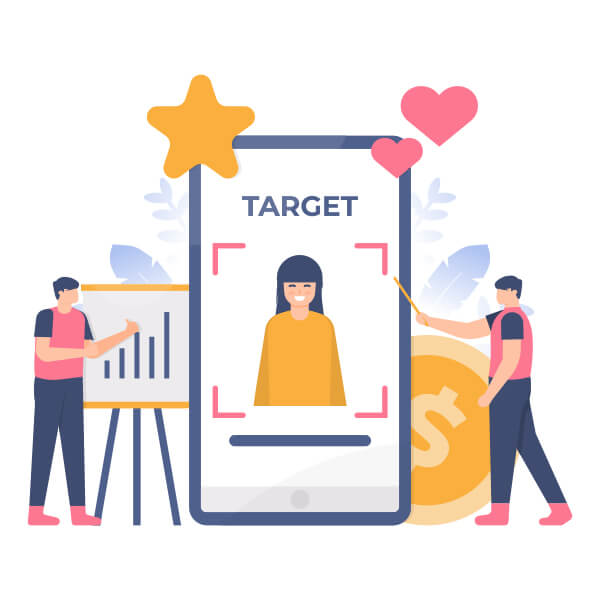We all know trying to appeal to everyone is one of the greatest marketing mistakes. As marketers, we’ve learned that defining a target audience is best practice, but how do we dig deeper than basic demographic details?
Beyond defining an age range, gender, location, and income level, there’s more to learn about your target audience. Read on to find creative ways you can learn more about your target audience.
Google analytics
While you already may be using Google Analytics, have you dug deeper than just the basic settings? Take the information you’re already receiving one step further to learn more about the audience visiting the pages for your company and/or products.
Interests

While age, gender, and location can tell you the basics about your audience, you can uncover additional insights by looking at the interests of the people visiting your site.
By clicking through to Audience > Interests > Overview, you’ll get an overview of the users’ interests visiting your site. For example, you can see the visitors to this website in October 2019 are organized by categories of their interests.
Technology and mobile
Most online statistics explain that mobile website traffic is booming, so you may assume your audience is also surfing the web on mobile. However, taking a closer look at your audience’s device and browser preferences can give you a ton of insights and help to prioritize more technical aspects of your campaigns or website upgrades.
While you may think, “as long as they are getting to my site, I’ve reached my audience,” taking a look at these measures can help you better optimize your site and direct your audience to learn more about you. For example, this can be especially key if your target audience is mobile users, but many are viewing from their desktop. Have you taken steps to optimize your site for the mobile experience?
Use analytic data to improve your marketing strategy
Social Insights
Understand who’s interacting with you online using social media analytics. Take a closer look at your demographics information and insights for each social network. Then, you’ll get a glimpse of which ones will best assist you in reaching the target demographic you’re after.
Facebook Insights
If you peruse through your Facebook insights, you’ll come across your people tab.
This tab will help you get to know your audience in three filters:
- Your fans: people who have liked your page and their Facebook demographic information (gender, age, location, language, etc.)
- People you’ve reached: shows statistics on the people Facebook showed your page to
- People engaged: people who have interacted positively with your page through liking, commenting, or sharing one or more of your posts
Getting to know your most engaged audience is key in deciding what kind of content to create moving forward or how you can target specific audiences.
Did you know there are Instagram analytics tools that go beyond just telling you how many likes your last post got or how many people viewed your story?
Instagram insights
Within the app (with a business account), you can learn about your audience, specifically when they’re online, what they’re clicking on, what they are liking, and more.
Iconosquare
If you’re looking for an overview of how your brand is excelling and where you could improve, you may consider Iconosquare. It’s a free Instagram audit that looks at your posts within the last 30 days and your profile overall. The audit will show you where you are doing great and where you’re falling short in improving your performance. This is a great tool for accessing if your current efforts for reaching your target audience are indeed working.
In your company account, navigate to the Analytics dashboard, and you’ll be able to view deeper insights on your LinkedIn profile.
View LinkedIn analytics such as:
- Visitors: people who visit your page
- Updates: metrics for engagement of content you’ve posted
- Followers: quantitative and qualitative demographic information about people who follow your page
Pro-tip: As you explore your social analytics, don’t forget to scope out the competition. While you may not have their analytics, you can:
- get a sense if your competitors are targeting the same market segments,
- learn if they’re reaching audiences you had not thought to consider, and
- find out how your content differs from theirs.
Getting a sense of how your competition operates (good or bad) can inform your marketing strategy. Bonus: You may spy some new tactics that resonate with your audience, or learn what not to do based on your competition’s mistakes.
Interviews
When getting to know your target audience, who better to ask than the members themselves? The best way to get information is to go right to the source with audience interviews.
Start by interviewing past or current customers, as they can help you understand their decision-making process, which factors had the most impact on their decision, and more.
Some options for interviewing your target audience include:
- An email survey
- A brief phone call
- Website and/or social media polls
- Face to face interviews
Another useful interview could come from the folks who are the “boots on the ground.” These are the members of your company who interact with customers the most (this may include salespeople, customer support, account directors, etc.). Ask individuals what they hear most. This information will often help you get a clearer picture of what your target audience needs.
When conducting interviews, don’t forget to ask questions that will give you insights into who this audience member may be. Additionally, think about what they may need to be fully reached by your efforts.
Learn how to use customer feedback for persona research
Take a walk in their shoes
To better understand audience needs, imagine what you might need if you were in their situation. Think about who they are as a person, their fears, their motivations, and what they value. By exploring relevant aspects of their life, you will gain insights into how your products or services would meet their needs.
Finding information and learning more about your target audience may seem like a great chore, but getting to know your audience can help increase your ROI (return on investment) and help you gain new clients /customers.

